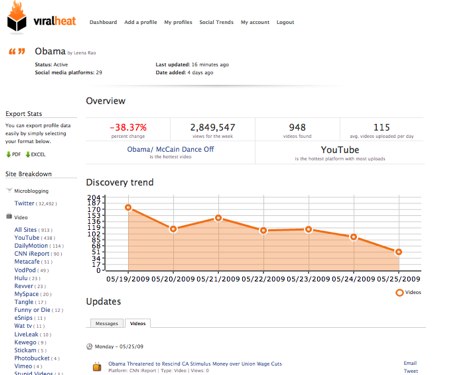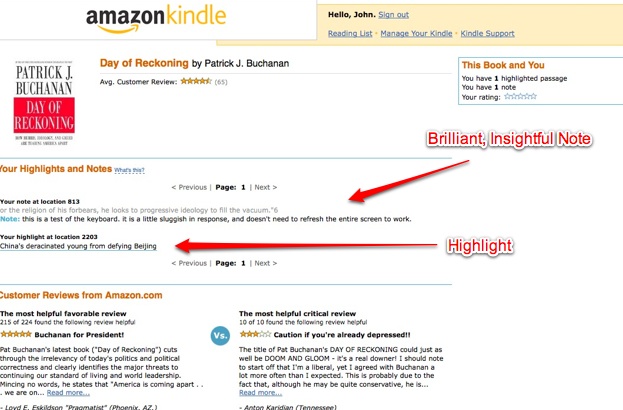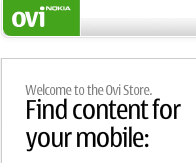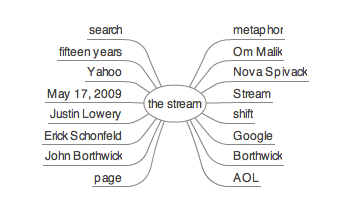The Latest from TechCrunch |  |
- When 1.3 Billion People Are Too Many
- Kindle Notes And Highlights Now Accessible On the Web
- OpenX Keeps On Growing, Raises $10 Million More
- Nokia Ovi Store Launch Is A Complete Disaster
- Nokia’s Ovi Store Opens For Business: 10 Must-Downloads To Kick Off
- Twitter May Not “Transform Television,” But Its Jump Is Interesting
- Smashwords Launches Flexible Ebook Affiliate Program
- RT: @Microsyntax Sets Out To Make Sense Of #twittergrammar
- 300 Things I’d Like To See From Twitter Before A TV Show
- Viralheat Measures And Analyzes Real-Time Content On Twitter, YouTube And More
- The App Store Hype Gets A Dose Of Reality
- LogLogic Raises $8.8 Million for IT Security Management Service
- Twitter Heads To Hollywood, Plans To Develop TV Show
- Connect Your Thoughts To The Mindex With Imindi (Private Beta Invites)
| When 1.3 Billion People Are Too Many Posted: 26 May 2009 07:36 AM PDT
There are a handful of industry-changing Web 2.0 names including MySpace, Facebook, YouTube, Twitter, and LinkedIn. But unlike those other Web 2.0 behemoths who have the luxury of waiting out revenue challenges as their user base surges and the economy recovers, YouTube’s runaway success meant extremely high bandwidth costs and legal worries early on. It's one of the only companies in that list that should have sold early while the momentum was high. Evidence: Nearly three years after the acquisition, the mighty Google still hasn't figured out exactly how to monetize all those eyeballs either. Industry estimates say YouTube spends half a billion or more a year in bandwidth costs. That's not to say it was a bad acquisition, particularly considering Google's stock currency was tantamount to monopoly money back then. But you have to wonder, if YouTube were alive today, how much more would it have been forced to raise and at what terms? You can get an inkling by looking at the fortunes of a handful of Chinese equivalents: YouKu, Tudou, and 56.com. The three tell a lot about the Web in China. YouKu is based in Beijing, Tudou is based in Shanghai and 56.com is based in Guangzhou – and each is representative of the YouKu and Tudou both claim to be the largest, while 56.com suffered from a several week government closure last June. The three are also emblematic of the flood of US money trying to get a piece of China: Among others, General Catalyst and Granite Global Ventures invested in Tudou, Sutter Hill Ventures invested in YouKu and Sequoia Capital, Disney and Adobe backed 56.com. The three are also examples of the Chinese habit of taking something popular in the US and doing the China version. The temptation is to think ideas that worked in the U.S. plus the world’s largest Internet market equals closest thing you can get to a sure thing. But the so-called "China Factor" has been a mixed blessing for these sites. 56.com's closure is emblematic of the challenges these companies face sitting at the crossroads of a closed China and a (more) open China, as user generated video blurs the lines of media and information and video is a powerful way of telling a story. But that's not the only unique "China Factor" challenge. The sheer size of the world's largest Internet audience is sucking these companies’ coffers dry, as they work to do what YouTube couldn't in the less developed Chinese online advertising market. The companies are literally growing too fast for their own good. As a result the number of players in the market have shrunk from 200 pure-play video sites in 2007 to about ten in 2008 and only a handful today. Those numbers are according to Gary Wang, CEO of Tudou. (Pictured above.) It was the first to launch back in 2005 and in the first six months of business the site did half the video traffic in China. That terrified Wang and his co-founder Marc van der Chijs. Today, the site has to proactively throttle back the size of its pipeline, knowing full well it’s giving a lot of users a bad experience. But Wang doesn't have much of a choice. He's raised a whopping $85 million and doesn't want to tap the markets again until his revenues are break even, and while growing, they're not close now. It's a catch-22: More traffic could bring in more ad revenues, but the bandwidth costs would also be too crippling to prove out the model. "We could be five to ten times bigger if we wanted to," he says. "It's purely a financial decision." All the Chinese sites have some advantages over YouTube. Chinese Web surfers tolerate a lot of ads and bling online and, with more limited media options, they tend to watch clips for longer. That means they won't necessarily balk at pre-rolls. Tudou has five-second pre-rolls, and YouKu has 15-second pre-rolls. And while a lot of haters like to call the sites nothing more than havens for pirated content, that's not exactly verboten in China the way it is in the U.S., so there’s not the same legal threat for now. The battle may be going on half-way around the world, but it has all the makings of a Valley-LA grudge match. Most of the people I met in Shanghai argued why Tudou was stronger, while those in Beijing argued YouKu had the edge. A few even said that 56.com's tech advantage and content partners like Disney could make it a compelling dark horse. But all three should probably worry less about each other and more about someone winning. Because that's the big fear of most people who live in China and love the sites: That the fire hose of traffic kills them before online ads catch up. And then it's back to those pirated DVD shops for everyone. Crunch Network: CrunchBase the free database of technology companies, people, and investors |
| Kindle Notes And Highlights Now Accessible On the Web Posted: 26 May 2009 06:10 AM PDT
About a half hour ago, Amazon opened up a new feature on the Kindle: the ability to read your notes and highlights on the Web. Readers have always been able to make notes and highlight text on the Kindle itself. Now those annotations appear on your account at http://kindle.amazon.com. Once you sign in, you can see all your notes. While this opens up all sorts of possibilities, Amazon is taking a very conservative approach. You can’t share your notes with others. You can’t even edit them in your browser. All you can do is read them. That makes the feature little more than a Web archive of your notes and highlighted text snippets. It is a convenient feature, but why not enable sharing? Why can’t I share an excerpt with my friends on Facebook or Twitter (with the beginning of a quote and a short link)? Amazon needs to connect the Kindle to the rest of the Web. Hopefully, this is the first step in that direction.
Crunch Network: CrunchGear drool over the sexiest new gadgets and hardware. |
| OpenX Keeps On Growing, Raises $10 Million More Posted: 26 May 2009 04:56 AM PDT
More recently, we covered the launch of OpenX Market, an alternative online ad exchange platform operated by the Pasadena, CA-based company. Today, OpenX is announcing that it has raised a Series C venture capital round to the tune of $10 million, which brings the total of funding raised by the company to a healthy $30+ million. Worth noting is that the extra financing is coming from a new lead investor, which is increasingly rare in these troubled times: DAG Ventures led the round, with existing investors Accel Partners, Index Ventures, Mangrove Capital and First Round Capital participating. Jonathan Miller, who recently was appointed as the new Chief Digital Officer of News Corp. also chipped in. OpenX CEO Tim Cadogan in a brief interview didn’t want to go into detail about the valuation of the company after this round, other than that he was pleased with it. He did say that there was still large part of the Series B round ($15.5 million, closed in December 2007) left on the company’s back accounts and that there was no real need for them to raise money, “which of course is always the best time to raise money”. Cadogan also told me the company is focused on making OpenX Market a success and to continuously add new publishers to its open ad technology platform Ad Server. To date, it has attracted over 38,000 publishers representing 150,000 websites for the latter, and Cadogan also informed me that Market has doubled since it launched a little over a month ago, with a current monthly run rate of over two billion impressions. More strong figures: OpenX claims that from December 2008 to April 2009, the monthly run rate of impressions for the OpenX Hosted product grew more than 500% to 7.5 billion impressions, with the number of sign-ups for the new product now exceeding 10,000 in six months since its debut on the market. (Disclosure: we use OpenX to power part of the ad serving here on the TechCrunch website) Crunch Network: CrunchGear drool over the sexiest new gadgets and hardware. |
| Nokia Ovi Store Launch Is A Complete Disaster Posted: 26 May 2009 04:24 AM PDT
Today sees the worldwide roll-out of Nokia’s Ovi Store, the company’s response to Apple’s App Store (and other centralized content stores for mobile phones and OS’es), and no doubt the company is watching the launch unfold on a global scale with watchful eyes. Here’s the thing: the launch is an utter disaster and I assume (hope) Nokia executives are outraged with the way things are going. Update: the Ovi team posted a response to the recurring problems, see below. Since I’ve seen the Nokia Ovi Store website come up a few hours ago, I’ve been trying to browse the selection of apps to select 10 that users should download to start off. I found that the store was down most of the time I was trying to snoop around, pages often didn’t load, and if they did they nearly always did extremely slowly. Despite the fact that I constantly needed to refresh and hope for pages to load, I figured that the service must be getting pounded from all the press it’s getting and was willing to forgive the slowness and regular downtime for the time being. But this has been going on for hours on end now, and there’s no sign of improvement. It gets worse. Out of the ten applications I recommended earlier today, three suddenly disappeared from the Ovi Store for no obvious reason. Searching for them yields no results, but they do pop up in the ‘related items’ section when you’re browsing alternative applications. Nokia offers no explanation why the content suddenly became unavailable, or if and when they will be back. Meanwhile, some apps are showing up twice (e.g. Qik). The user experience sucks too. Navigating the online store is downright complicated, and the categories being assigned to certain applications and content are way off at times. Entering basic search queries (e.g. ‘games’) often leads to zero results or a freezing page. Publisher profiles sometimes have nothing but a poorly embedded logo, an extremely short description and no link to their own website (e.g. inTouch). To add insult to injury, we hear people with an Ovi account are unable to use their credentials for logging on to the new service, but that they are being told that there’s already a profile with their username when they attempt to register for a new account. That means Nokia is basically blocking registered users from using its new service at this point. Update: All About Symbian lists more problems that need solving. I’ve contacted Nokia’s press services to give them a chance to respond and detail how heavy the load on their servers has been this morning, but the only conclusion I can make at this point is that the Ovi Store launch is a complete fail on Nokia’s part with a service being rushed out the door before it was ready for prime time. My advice to Nokia: tell us you’re open for business when you actually are. Update from the Ovi team:
Crunch Network: CrunchBase the free database of technology companies, people, and investors |
| Nokia’s Ovi Store Opens For Business: 10 Must-Downloads To Kick Off Posted: 26 May 2009 03:18 AM PDT
Nokia claims more than 50 of its mobile devices are compatible with the service as of today, with more slated to roll out over time, and estimates that around 50 million people with Nokia devices will be able to license content and download applications from the Ovi Store right now. The news is now completely out there and people are testing the service like crazy, which means it can be a little slow or downright unresponsive at times. Update: actually, the launch is a complete fail. We’ve browsed the online store extensively and hand-picked 10 applications we think you should download and install first. Note that the available content you can download depends on which device you’re using, we’ve selected the option ‘any phone’ to increase the chances of these being available for you as well: * Qik (Photo & video, free) - Ovi Store listing: a powerful way to share live video from your mobile phone with friends everywhere you go. MobileCrunch knew it was going to be one of the featured apps in the store back in March. * FlyScreen (News & Info, free)- Ovi Store listing: an application that lets you add your favorite web services (in widget form) to your phone's sleep screen, enabling zero-click access to the content you use most. * Photobucket (Photo & video) - Ovi Store listing: lets you log in to your Photobucket account, upload photos from your phone to your album and search its public repository of photos. * Flight Info (News & Info, free) - Ovi Store listing: key in any airline code and flight number and track terminal, departing and arrival information. * Assassin’s Creed (Games) - Ovi Store listing: end the Third Crusade from your mobile phone. Update: seems to have disappeared from the store somehow. Alternative: Wolverine (€5). * Twittix (Social Networks, €1) - Ovi Store listing: Yup, it’s a mobile client for Twitter. * MobiSystems OfficeSuite 5 (Business, €20) - Ovi Store listing: OfficeSuite is a complete mobile office solution, allowing you to create, view and edit Word, Excel and PowerPoint files away from your office. Support MS Office 2007 files. * RISK (Games, €5) - Ovi Store listing: Enjoy the classic board game playing against up to five cunning computer opponents, each with distinctive tactics and unique levels of aggression. * AP News (News & Info, free) - Ovi Store listing: Yes, we know, it’s AP, but this app does give you a good overview of breaking news and photo galleries to boot. * World Traveler (Utilities) - Ovi Store listing: allows travelers to plan and manage journey activities and provides instant access to relevant information and services. Update: seems to have disappeared from the store somehow. Alternative: WorldMate 2009 (free). Crunch Network: CrunchBase the free database of technology companies, people, and investors |
| Twitter May Not “Transform Television,” But Its Jump Is Interesting Posted: 26 May 2009 03:08 AM PDT
It’s simple really: Twitter has signed an agreement with a production company to allow them to develop a show based around the service. Stone was vague when it comes to specifics, but it reads like Twitter will have little if anything to do with the show, and really will just lend its name and likeness (perhaps even in the title). It’s similar to what the company has done in the past with Current (for Hack the Debate) and CNN (for its various shows that heavily use the service). And it’s similar to other projects that are in the works with a few other networks. But it’s still quite interesting for a few reasons. First, from what Stone wrote, it sounds like Twitter hopes this will be the first of many shows built around the service. That’s interesting because it’s an extension of Twitter’s goal to be a powerful new platform. It already is one on the web, but that’s now expanding into different mediums, like television. And that’s notable because you don’t see many other startups — or even big web companies — make that jump.
Second, one would assume that Twitter stands to benefit financially from such television deals. While it won’t be Twitter’s ultimate business-model, if a network were to pick up any Twitter show, the revenue split with Twitter would undoubtedly be more substantial than say, a partnership with a third-party website built on top of Twitter. Third, this movement of Twitter into the entertainment sphere, does raise some interesting questions about Twitter versus TWiT (This Week In Tech), Leo Laporte’s popular video and podcasting network. This has been an issue in the past, but died down because ultimately TWiT and Twitter were in two different games. But if Twitter enters Laporte’s world, he may be moved to respond with his trademarks, as he noted yesterday. “Twitter’s open approach might have the power to transform television—the dominant communications receiver worldwide,” Stone said of the news. That reads a bit arrogant, or at the very least presumptuous, and while it would be easy to immediately dismiss such a comment, it does speak to Twitter’s potential power as a platform. Because the service hasn’t yet bloated itself with the bells and whistles that other services have, and has stayed mostly true to its quick, mobile usage roots, it could be the one startup that is able to break out of the web service stigma. Yes, plenty of services have “mainstream” usage now, but those are still considered web properties that regular people just happen to use.
It brings me back to perhaps my favorite scene from the television show Mad Men. While setting up his presentation for Kodak’s new Carousel slide projector, Don Draper says, “Technology is a glittering lure. But there’s the rare occassion when the public can be engaged on a level beyond flash. If they have a sentimental bond with the product.” For an increasing number of us, Twitter is starting to fall into that category. Whether the larger public can be engaged in the same way, remains to be seen. For now, it remains a glittering lure. Crunch Network: CrunchBoard because it’s time for you to find a new Job2.0 |
| Smashwords Launches Flexible Ebook Affiliate Program Posted: 26 May 2009 02:08 AM PDT
Affiliate programs for bookstores are nothing new. Typically online publishers will link to a book and will get a cut of the proceeds if the store linked to makes a sale within a certain timeframe. But the emergence of Ebooks is changing the landscape. Amazon, which has built up its affiliate program for traditional books over the last decade, does not give affiliate publishers any portion of the purchase price if a visitor winds up buying an electronic book. Smashwords is looking to capitalize on this omission by offering web publishers an alternative. The Smashwords affiliate program is offering commissions of 11% of the net selling price (the sale price less any PayPal fees) for all of its online books (authors can optionally opt out if they’d like). And the store is giving authors and publishers the ability to control how much of a commission they’d like to offer above that 11% - so an author could bump it up to 50% or 80% if they were willing to exchange revenue for increased exposure. You can find the full details of the program here. Smashwords launched a year ago, and has grown to offer 1,300 Ebooks primarily from independent authors, though some small publishers are beginning to sign on as well. All of the content sold is DRM-free (you can read it on your computer, or devices like the Kindle) and authors receive 85% of the net proceeds of any Ebooks that they sell. Other players in this space include Fictionwise and Scribd, which just launched its online store, though neither of these offer an affiliate program. Crunch Network: CrunchBoard because it’s time for you to find a new Job2.0 |
| RT: @Microsyntax Sets Out To Make Sense Of #twittergrammar Posted: 25 May 2009 07:21 PM PDT
One of the side effects of Twitter’s 140-character limitation is that users are coming up with their own microsyntax and abbreviated Twitter grammar to make their Tweets more expressive. If your are merely retweeting someone else’s tweet, for example, you acknowledge that by placing a “RT” at the beginning of your micro-message. If you are replying publicly to another user or just referring to them, you indicate that with an “@username.” You can even add hashtags to a tweet so that it shows up in searches for specific topics (please use “#twittergrammar” if you are going to RT this post). New conventions pop up every day. To make sense of them, and develop new ones, Stowe Boyd is launching Microsyntax.org tomorrow. In a debut blog post, he insists that it is not a “standards body,” but that is effectively what it might become. And we need one, because Twitter isn’t setting any standards. You can follow @microsyntax to keep on top of the latest Twitter lingo. Microsyntax is not just about coming up with commonly used abbreviations. It is also the way that structure can be added to the mess that is Twitter today. Hashtags, for instance, lets you find all tweets about a particular subject or event. We probably need more microtags for different purposes. The problem with the microsyntax approach, however, is that it appeals mostly to the command-line crowd instead of to the average user. Nevertheless, if a microconvention becomes popular enough, then Twitter itself can adopt it, as it has with the @replies (although it has messed that up by mixing in retweets that simply mention your name and aren’t truly replies, but I digress). What’s your favorite microslang and what do we need to add to the microlexicon? Crunch Network: CrunchBoard because it’s time for you to find a new Job2.0 |
| 300 Things I’d Like To See From Twitter Before A TV Show Posted: 25 May 2009 03:56 PM PDT
Twitter has not yet responded to an email, but investor Fred Wilson seems to think it’s a good idea, saying “TV isn't TV anymore. It's just the largest screen in the house.” So we’ll wait for more details of the show to surface before we write the inevitable blog post trashing the idea (update: details!). In the meantime, Twitter, as a heavy user there are a nearly unlimited number of things I’d so much rather you guys spend your time on than going Hollywood. Here’s a few key ones, I’m guess lots more will show up in the comments and we’ll get to at least 300 or so things Twitter could better spend its time. Keep The Lights On. Twitter is still not a stable service. Fix Track. This is the “Google Alerts” feature of Twitter that made a brief appearance in 2007 but was stripped out in the uptime wars of 2008. It may have made sense to remove it at the time, but we’re long past due on this much needed feature. Fix Search. Twitter’s main value is as a search engine, and it’s pretty broken. There’s lots of work to do here. Stop Breaking Stuff. Twitter just doesn’t seem to feel comfortable in its own skin, making changes to suit the masses that are just confusing and need to be reversed. Fix Private Messages. Twitter’s direct messages (private messages) has occasional hiccups. Sometimes they are mis-delivered, as in they go to the wrong person. That just can’t happen. Maybe Launch Some Features. Twitter is so concerned with uptime that they rarely (never) launch new features. Sites like FriendFeed are embarrasing them with innovation, and others like Facebook are copying the core Twitter service. I get that uptime is important, but if you have time for meetings in Hollywood, you have time to add new features. Spend that time interviewing new engineers at the very least. You need more people badly. Ok, that’s six. Let me know what you’d like to see Twitter do before working on a television show in the comments, and we’ll add the smartest and most entertaining to the main post. Update: Some of the better suggestions from comments: Groups/Friend List — @zee and @blackrabbit Increased/No limit for API requests — Sam Houston and Jeff “A business model.” — @robinwauters Spam filtering — Sean Percival Integration with Steam — @carltonprest 30-second edit window — @Sheamus Analytics — @MiikoMentz iTunes Genius-like recommendations engine — Wesley Barrow Auto-linking of hashtags — @silvaldropout Threaded conversations — jcunwired Some of the suggestions were a bit more amusing: “surrendering to FF” — Johnny Schroepfer “Limit the amount of followers a cat can have to 499,999.” — @robinwauters “Gonorrhea - something I'd like to see before a Twitter TV show.” — Dante “A phone number where I can short the stock of the TV network that plans to air this show.” — swag “I'd like to see Twitter allow people to order cheesecakes by tweeting @twittercakes, before I would like them be involved with a TV show.” — @chacha102 Crunch Network: MobileCrunch Mobile Gadgets and Applications, Delivered Daily. |
| Viralheat Measures And Analyzes Real-Time Content On Twitter, YouTube And More Posted: 25 May 2009 03:45 PM PDT
As YouTube and Twitter have become essential marketing tools for brands and companies, there has been an emergence of startups that help marketers track the buzz around a certain individual or brand. Radian6, Visible Measures, Omgili, Omniture and a plethora of others offer tools to monitor blogs, Twitter, YouTube, Facebook and other social media sites for mentions of a company or individual’s name. Startup Viralheat is entering this space with the private beta launch of its affordable social media measurement product that scours social video sites including YouTube, Hulu and Vimeo, and Twitter to deliver real-time results of consumer generated content on these sites. Viralheat allows you to create profiles to track an individual’s name or a company’s name across nearly 30 video sites and Twitter. The platform’s Twitter tool provides data on how many total mentions an item had on Twitter for the week and for the given day, the most active Twitter user who has Tweet about a brand, the most common language of Tweets, percentage of Tweets about a brand that are Retweets, the most active day of the week for mention of a brand and a sentiment breakdown of Tweets. For example, a profile created for “Obama” shows there were just over 7,000 tweets today including the name “Obama,” and over 32,000 total Tweets this week. The service also provides a graph of the number of Tweets over the past week and shows the most recent Tweets about the item updated in real-time, which you can Tweet out directly from Viralheat’s platform or email to others.  The video tool will filter the breakdown of a brand or individual over video sites, letting you know how many mentions were made over each video platform. The video dashboard will let you know what the most popular video was, how many videos were found with a certain brand or name in a given week, the average number of video downloads per day and how many total views the videos received in a week. Similar to the Viralheat’s twitter feed, the site pulls in a real-time feed of the videos and allows you to email or tweet links to the videos directly from the platform.  Any data from the Twitter and video dashboards can be exported directly into PDF files or Excel spreadsheets, making it easy for marketers to share this data with others. Viralheat also lets users share a snapshot their profiles of brands, trends, individuals, etc. with the public. Under a trends page, anyone can see the performance of profiles of brands or individuals broken down by subject (politics, sports, movies, television). Viralheat’s service could be a cost-effective and user-friendly way to view social metrics data from Twitter and video sites. And the price for the tool is easy on the wallet—for $10 per month, you can track 10 profiles on the site. For $40 per month, you can track 50 profiles. There’s no doubt that tracking Twitter is useful to companies and brands, but Viralheat’s reach is currently limited. One major drawback is that the site doesn’t allow you to track other social networks where brands are commonly mentioned, such as blogs, Facebook, MySpace, LinkedIn and Flickr. The startup says that it has plans to incorporate blogs, sites and social networks into its dashboard over the next few months and will not be planning to change its pricing structure when these services are added. Viralheat also plans to add an app store-like marketplace where users can add extra tracking items, such has the ability to track top keyword searches and tags for a profile. Crunch Network: MobileCrunch Mobile Gadgets and Applications, Delivered Daily. |
| The App Store Hype Gets A Dose Of Reality Posted: 25 May 2009 01:48 PM PDT
Surprised? You shouldn’t be. As marketplaces go, the App Store has a very low barrier to entry that makes it easy for anyone to sell their wares, which means that it’s flooded with apps. There’s no way Apple could prominently present these 36,000 applications to users without overwhelming them, which means most apps fall into obscurity as soon as they’re submitted. If you can’t find a way to get the word out, nobody is going to find your app on their own. Now, as someone who regularly likes to cover the success stories of the App Store, I thought this would have been fairly obvious to other developers and have thus failed to insert disclaimers that these cases were not typical results. But the fact that Strom’s post was written seems to indicate that perhaps we need to make this a bit clearer. So here goes: The App Store probably will not make you rich. To underscore the point, let’s go over some of the stats presented by Strom. His application Zen Jar ranks #34 on the Social Networking top apps list. And while most of us would probably assume it would take at least a hundred daily downloads to place there, the reality is quite surprising: Zen Jar reached the 34th position with only 30-35 downloads a day (or around $20 a day for a 99 cent app). Similarly, Sprint Board Pro, which ranked 95th in the Board Games section of the store with 6-8 daily downloads. Granted, these aren’t exactly the most popular categories, but If it takes fewer than 10 downloads a day to make the top 100 bestsellers of any category, that’s saying something.  Strom likens the App Store to a lottery, with the time and cost spent developing your application as the price of admission. And I think he’s right in this respect. The thing is, I don’t really see how this differs from many professions where the rich and elite are given heavy media coverage while everyone else toils away in obscurity. This is true for the entire entertainment business, where actors train for years just so they can vie for a limited number of spots. Most writers struggle to have their books published, let alone see them become popular. Basically any job that has the potential to make you rich is going to require a combination of hard work, talent, and luck. Those with lower barriers to entry will see huge amounts of competition. There’s a reason everyone isn’t wealthy. Strom writes that software entrepreneurs frequently use the “huge successes” of a market to gauge its potential, rather than looking at the average outcome. I think this may be true for some of them, just as some would-be actors venture to Hollywood with the expectation of simply jumping into the spotlight only to find themselves waiting tables at a diner. But I think that most developers understand the risks involved, and how unlikely it is that their app will hit the big time. The same can be said for most of the web entrepreneurs I meet. They may invest many months or years into their work, but they know that the vast majority of new online ventures are bound to fail. So for all of you iPhone developers who are new to these somewhat discouraging facts of life, I’m sorry if I (and the media as a whole) have failed to underscore the low probability of striking it rich on the App Store. To those of you who keep building things anyway: rock on. Crunch Network: MobileCrunch Mobile Gadgets and Applications, Delivered Daily. |
| LogLogic Raises $8.8 Million for IT Security Management Service Posted: 25 May 2009 12:00 PM PDT
LogLogic, a security and log management firm that helps companies sort though log data and manage their IT systems, has raised $8.8 million in an extended series D round of funding, led by Focus Ventures with Sequoia Capital, Telesoft Partners, Worldview Technology Partners, INVESCO Private Capital, SAP Ventures, CM-CIC Private Equity, Crédit Agricole Private Equity and ELAIA Partners participating. This brings LogLogic’s total funding to $58 million. LogLogic plans to use the financing to fuel growth into new markets, including database activity monitoring. LogLogic recently acquired security management company, Exaprotect, for an undisclosed amount. LogLogic offers companies a suite of software products that helps IT departments make sense of logs of IT audits, compliance, threats, and other operational data. Competitors in the secerity management space include RSA, IBM and ArcSight. Crunch Network: MobileCrunch Mobile Gadgets and Applications, Delivered Daily. |
| Twitter Heads To Hollywood, Plans To Develop TV Show Posted: 25 May 2009 10:40 AM PDT
Twitter is crossing mediums to develop a TV show, according to a Variety report. Joining forces with LA-based production companies Reveille Productions and Brillstein Entertainment Partners, Twitter plans to launch an unscripted show that will put “ordinary people on the trail of celebrities in a revolutionary competitive format.” Variety says the show’s concept was the brainchild of novelist Amy Ephron. Founded by NBC Entertainment exec Ben Silverman, Reveille Productions is known for producing TV hits like ABC’s Ugly Betty and NBC’s The Office. The company was apparently bought by Elisabeth Murdoch’s Shine Productions in February 2008 for $125 million. Update: Tell us what you’d rather see Twitter work on before a TV show. (Photo credit: Flickr/Vlastula) Crunch Network: CrunchBoard because it’s time for you to find a new Job2.0 |
| Connect Your Thoughts To The Mindex With Imindi (Private Beta Invites) Posted: 25 May 2009 09:32 AM PDT
What doesn’t kill you will only make you stronger. Adam Lindemann learned that the hard way with iMindi, a startup trying to create a “thought engine” that was skewered by our judges at last year’s TechCrunch50. “It almost destroyed us,” says Lindemann. But he and his team have completely redesigned the product, which creates a mind map of your thoughts based on semantic indexing technology, and lets you “merge” those thought maps with related ones created by other people. It is still rough around the edges, but is a vast improvement over the original concept. Today, iMindi is launching in private beta, and we have 1,000 invites for TechCrunch readers (sign up here). The drubbing iMindi received at TechCrunch50 last year was brutal. After Lindemann’s presentation (see video below), Mark Cuban, who was a judge, laid into him:
Lindemann and his co-founder Galen Kaufman were devastated. Investors wanted to pull out. “It was a complete disaster,” says Lindemann, “but it was the best thing that could have happened because they were essentially right. If we would have launched in September, we would have failed.”
The main problem with the original design was that users were expected to manually connect their thought maps to other people’s thought maps. It was very labor intensive, and it wasn’t clear why anyone would invest the time. There are still some UI issues, but the connections are now automated, and it is easier to dump in data from other places on the Web. Let me take a step back and explain what iMindi is today and what it hopes to become. When you create an account, you are encouraged to sign up for different “think tanks,” which are topic areas of interest. These include “Innovation & Technology,” “Wealth and Finance,” Fashion and Style,”"Travel and Adventure,” Sports,” “Pregnancy and Parenting,” and “Mind, Spirit, and Religion.” You can create your own think tank topics. Once you’ve signed up for a few think tanks, you are ready to enter your “thoughts” on that topic.
You can enter your thoughts directly, just like writing a blog post. Or you can cut and paste from blogs, articles, or other sources on the Web. (Soon it will be possible to ingest your existing thought stream from other sources, such as an RSS feed from your blog or your Twitter feed). Once you you are done entering your thought, iMindi runs it through its semantic index and creates tags for all the major concepts it recognizes. The concepts are hyperlinked in your post and presented as a thought map below. Clicking on any concept reveals other entries you have made with the same semantic tags. If they are truly related, you can “merge” the two thoughts and they will be connected on the mind map.
iMindi is still hit or miss in identifying and mapping the right concepts. For instance, I entered a post I wrote called “Jump Into The Stream” and it produced the mind map at right. It correctly identified the people mentioned in the post, a date, and the fact that the “stream” is a “metaphor” for information consumption related to another metaphor, “the page.” But other than “Yahoo” and “Google,” it failed to identify any of the smaller companies at the center of redefining teh Web in terms of information streams (Twitter, Facebook, FriendFeed, etc.). So its semantic index needs to get better, but it would be easy for iMindi to allow users to add their own tags or edit existing maps. Where this becomes interesting is that you can also find other people whose posts/thoughts have created the same semantic tags, and merge your mind map with theirs. In this way, iMindi hopes to help you find like-minded people. Once you do find them, you can follow them and their thoughts in the think tanks where your interests overlap. The more people who merge their maps with yours, the greater your “mind rank.” You also can see everyone’s thoughts in a particular think tank as a stream when you explore that think tank. In this sense, iMindi shares an approach with Twine, which is also powered by a semantic index and lets you follow other people’s interest feeds. Twine is much better funded and at a more mature stage of development. (Twine’s parent company, Radar Networks, has raised $18 million, whereas iMindi was built with only $500,000 so far). But iMindi’s focus on creating these mind melds is promising. We are increasingly drowning in people’s thought streams already (Twitter, Facebook, FreindFeed, you name it). iMindi today is still too much work. But if it follows through and lets you actually ingest these thought streams you are already creating and following elsewhere, it could be a valuable filter. Imagine being able to map your entire Twitter stream, or the streams of individuals you are following, or just individual Tweets, and mapping those across time. Putting a semantic layer on top of Twitter, or any stream of content is a powerful way to explore related thoughts and concepts. The mind map connects related thoughts not by links, but by analyzing the underlying language used to express those thoughts. In a world of ever-larger information streams, we need better ways to navigate those streams. Semantic mind maps could be one way. iMindi still has a lot of work to do before we get there. It needs to remove steps from the way it lets you create “thoughts” and link to other thoughts. Personally, I’d lose the think tanks concept or put it into the background. Right now, if you don’t look in the right think tank, you might miss a related thought if somebody entered it into another category. iMindi needs to let its thought engine do even more of the work in connecting thoughts together, or at least exposing them to users. Lindemann is aware of these limitations, and is keeping an open mind about how to make iMindi work. Sign up for the beta and give him your thoughts.
Crunch Network: CrunchBoard because it’s time for you to find a new Job2.0 |
| You are subscribed to email updates from TechCrunch To stop receiving these emails, you may unsubscribe now. | Email delivery powered by Google |
| Inbox too full? | |
| If you prefer to unsubscribe via postal mail, write to: TechCrunch, c/o Google, 20 W Kinzie, Chicago IL USA 60610 | |
 There's one big Web 2.0 question we'll never know the answer to: Could YouTube have survived on its own?
There's one big Web 2.0 question we'll never know the answer to: Could YouTube have survived on its own? strengths of the region, according to several dozen interviews I did in China over the last two weeks. Situated at the nexus of Chinese startup culture and government influence, YouKu is widely credited as being the best at playing the startup game. Drawing off the Shanghai’s strength as a media hub, Tudou prizes self-expression as you can see by its Facebook-esque employee-graffiti-ed walls (right). And like a lot of emerging Chinese tech powerhouses to come out of the Guangdong province, some say 56.com has the best sheer technology of the bunch.
strengths of the region, according to several dozen interviews I did in China over the last two weeks. Situated at the nexus of Chinese startup culture and government influence, YouKu is widely credited as being the best at playing the startup game. Drawing off the Shanghai’s strength as a media hub, Tudou prizes self-expression as you can see by its Facebook-esque employee-graffiti-ed walls (right). And like a lot of emerging Chinese tech powerhouses to come out of the Guangdong province, some say 56.com has the best sheer technology of the bunch.

 We’ve talked about online ad server
We’ve talked about online ad server  This was supposed to be a glorious day for mobile phone giant
This was supposed to be a glorious day for mobile phone giant  Nokia’s very own centralized application marketplace, dubbed
Nokia’s very own centralized application marketplace, dubbed  When news broke earlier that Twitter was working with some Hollywood types to
When news broke earlier that Twitter was working with some Hollywood types to  While the service has seen
While the service has seen  We may not like to admit it, but it’s still just not considered very cool to use any of these services rather than say, actually meeting up with a group of friends in person. But we’re moving to a world where not only will using these services move beyond seeming like something that geeks do, but where you don’t even think about the notion of a “web service” or being “offline.” An ascension of Twitter into entertainment could hasten that. I’m not saying that it will — hell, the Twitter show could absolutely suck — but I am saying that no one is developing television shows entirely around Facebook.
We may not like to admit it, but it’s still just not considered very cool to use any of these services rather than say, actually meeting up with a group of friends in person. But we’re moving to a world where not only will using these services move beyond seeming like something that geeks do, but where you don’t even think about the notion of a “web service” or being “offline.” An ascension of Twitter into entertainment could hasten that. I’m not saying that it will — hell, the Twitter show could absolutely suck — but I am saying that no one is developing television shows entirely around Facebook.



 Yesterday developer Rick Strom wrote a blog posted titled “
Yesterday developer Rick Strom wrote a blog posted titled “






No comments:
Post a Comment